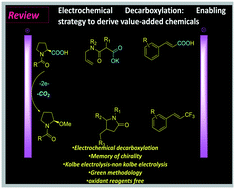Organic synthesis via Kolbe and related non-Kolbe electrolysis: an enabling electro-strategy
Abstract
An efficient and environmentally friendly synthetic methodology is preferred over conventional methods that require expensive chemicals & oxidants to achieve value-added organic transformations. Electrochemical conversions encounter conventional shortcomings and introduce easy scale-up methods to synthesize complex and hindered molecules employing electricity as a clean reagent and catalyzing entity. Electrochemical conditions minimize waste formation and increase the chances of getting the maximum amount of target products under ambient conditions. The Kolbe and related non-Kolbe electrolysis process where the anodic oxidation of carboxylic acids leads to decarboxylation can be used intelligently to form new bonds and achieve value-added molecules and stereoselective products. The memory of chirality, where we have contributed to, is a more fascinating strategy to achieve highly desired asymmetric products via electrochemical decarboxylation (ED). Besides this, coupling (homo, hetero), dimerization, addition, cyclization, and CH activation via ED are also significant aspects of this strategy. Flow electrochemistry and photochemistry using the ED strategy could enhance the selectivity and product yield, avoiding overoxidation. Herein, we discussed several examples of ED and its applications to drive value-added transformations under mild, clean and sustainable conditions and also addressed mechanistic aspects. This ED approach will enable and provide inspiration for future applications in electro-organic synthesis.



 Please wait while we load your content...
Please wait while we load your content...